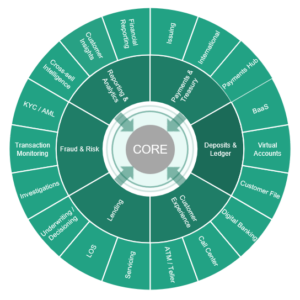Surround and Squeeze: A Core BankTech Thesis
By: Sasank Chary & Andy Greos
As growth investors, we see a compelling opportunity in software and fintech providers catering to banks. The thesis is simple but powerful: banks are increasingly seeking solutions that help them modernize while containing their existing legacy infrastructure. This trend opens the door for modular, best-of-breed solutions that deliver modern capabilities without a complete overhaul. Let’s dive deeper.
Banks on a Mission to Modernize
The competitive landscape for banks has shifted dramatically over the last decade. Several structural shifts are forcing banks to rethink their technology stack:
- Fintech Competition and Customer Expectations: Fintechs have raised the bar with sleek, digital-first experiences. As a result, customers now expect intuitive, omnichannel banking that mirrors the convenience they find in other consumer tools. Banks are under pressure to match this standard.
- Evolving Economics: Recent bank failures have made it clear that deposits are far more fluid than once believed. At the same time, traditional revenue streams are being squeezed, increasing the urgency to retain and better serve customers.
- Regulatory Complexity: Compliance demands are intensifying, pushing banks to adopt more flexible, auditable, and integrated technology platforms.
At the same time, two major technological shifts are accelerating the urgency to modernize:
- Real-Time Payments: With FedNow and RTP live—and stablecoins looming—banks need real-time capabilities. But most legacy cores can’t support the speed, flexibility, or data transparency these new rails demand.
- AI-Ready Infrastructure: Banks increasingly want to leverage AI for personalization, fraud detection, and analytics—but their data architectures aren’t built for it. Legacy systems lack the integration and agility required to power advanced decisioning.
Banks are making digital modernization a top priority. They are appointing Chief Innovation Officers and forming dedicated transformation teams with a clear mandate: find and implement technology that enhances agility, customer experience, and competitiveness.
So what stands in their way? A Core problem…
Low Satisfaction with Incumbent Banking Core Providers
Core banking systems—largely dominated by long-standing providers like FIS, Fiserv, Jack Henry, Finastra, and Temenos—power everything from the central ledger to payments, deposits, and account servicing. While functionally reliable, these systems are often decades old, on-premise, and difficult to scale or customize. Over time, many have grown through acquisitions, creating siloed, disjointed platforms that lack the data consistency and interoperability required for modern use cases.
Banks routinely cite frustrations with their cores, including:
- Poor connectivity across business lines
- Limited ability to support real-time processing
- Outdated interfaces and slow product development cycles
In fact, according to ABA surveys, over 60% of banks report dissatisfaction with their core banking platforms. Despite this dissatisfaction, only 14% of banks say they are likely to switch [Source: ABA 2022].
Why the disconnect?
One, these systems, while outdated, are reliable. Second, the costs and complexities of migrating to a new core are daunting and often insurmountable for mid-sized banks. The costs potentially include running parallel cores, complex integrations, and massive operational change management. Moreover, the risks of data migration errors or operational disruption add further deterrence. The recent Synapse/Evolve mishaps underscore the consequences. In banking, 99% accuracy is not an acceptable outcome.
“Surround and Squeeze” – A Path Forward
Recognizing the barriers to innovation, we increasingly see banks adopting a strategy to “surround and squeeze” the core: containing the core to its essential functions, such as the central ledger, while implementing modular solutions around it that can provide the modern experiences and capabilities they seek. These third-party systems address targeted needs – such as digital onboarding, real-time payments, fraud analytics, and customer engagement – seamlessly integrating into legacy systems without disrupting core operations.
This phased approach offers the best of both worlds: it allows banks to innovate quickly and selectively while maintaining the operational reliability of their existing systems.
Importantly, many of the functions that banks are now “squeezing” out of the core—like payments, account opening, CRM, and risk—have historically been bundled by the core providers themselves. These are now increasingly being unbundled and replaced with best-of-breed alternatives. That shift expands the addressable market for new entrants far beyond just the core ledger.
The visual below illustrates how modern BankTech providers are building around the core, solving specific problems and delivering real value without requiring a full rip-and-replace..
The Opportunity For BankTech
This shift creates a massive opening for banking tech providers. The combined revenue of the major core processors exceeds $20 billion annually. Many of the services they provide—beyond the ledger itself—are now vulnerable to modular disintermediation. Even capturing a fraction of these functions represents a multibillion-dollar opportunity.
While some view bank consolidation as a headwind, it has actually created more scaled, mid-sized institutions with both the urgency and resources to modernize. Since 2014, the number of banks in the $5B–$100B asset range has grown by over 60% [Source: FDIC, NCUA data]. Many are led by a new generation of decision-makers who are more open to third-party solutions and less wedded to legacy vendors.
Banks are still difficult to sell to. Procurement is slow, compliance hurdles are high, and many institutions still default to their core provider. But the combination of market pressure, leadership turnover, and maturing modular technologies is creating a more receptive environment for modern vendors.
Conclusion
The case for modular BankTech has never been stronger. Banks are under pressure to modernize but remain anchored to legacy cores that limit their ability to move fast. The “surround and squeeze” strategy offers a practical path forward that allows banks to unlock new capabilities and improve customer experiences without the risk and cost of a core replacement.
For modern software providers, this is a generational opportunity. Banks are increasingly dissatisfied with their incumbent vendors and are open to new approaches. The next wave of BankTech winners will be those that integrate seamlessly, solve real problems, and help banks thrive in a digital-first world.
